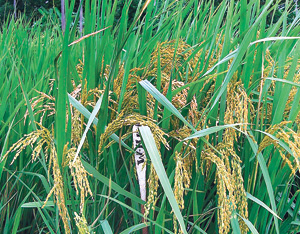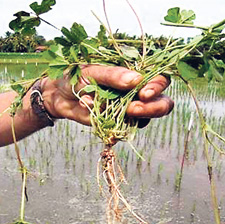"My paddy was maturing well, promising good results. But suddenly, certain patches in the field started getting acid burns and dried up," lamented Piyadasa, a rice farmer in Gonapola talking of his lost harvest.
The debacle that Piyadasa faced, which was experienced by hundreds of farmers during the recent Maha season was a result of the Brown Plant Hopper - one of the worst rice pests farmers have encountered in recent times. Earlier, though farmers have had to contend with pest attacks on their rice crops, the situation was not this bad, Piyadasa said.
Has the pest then really evolved to attack crops on a larger scale now?
Experts say in fact it is the resistance of the crops to pest attacks that has weakened. Agro-researchers who focus on making high yield rice varieties through the process of hybridization cross-breed 'high yield' seeds again and again. This way, the 'high yield' characteristic genes are transferred to the commercial rice varieties, but their resistance genes are not improved. Since there is also hardly any diversity among the cultivated rice varieties, the rice plants become more prone to diseases and pests.
The Rice Research Institute (RRI) at Bathalegoda has come up with an answer they hope will provide relief to paddy farmers in the near future.
 |
| Rice plants being experimented with wild rice genes |
"We had identified a new Brown Plant Hopper pest-resistance gene from a wild rice species scientifically known as Oryza nivara and we are in the process of introducing it to commercial rice crop varieties through hybridization," said P.V. Hemachandra, a research officer at RRI. This wild rice is different from the species Oryza sativa, that is grown commercially. "It is not easy to make hybrids with two different plant species, but we have been successful in getting the pest resistance genes transferred to the commercial crop variety," Mr. Hemachandra explained.
Oryza nivara is a wild rice species that grows unnoticed near aquatic environments like irrigation tanks in dry and intermediate climatic zones. There are, in fact, four other different wild rice species that grow in different areas. One wild rice species is found in coastal ecosystems and carries genes that are resistant to salinity. Another is a perennial species. Such special characteristics hidden in the genetic diversity of the 'wild relatives' of the rice plant can hold great value, but unfortunately most of them are simply considered weeds and destroyed.
Almost all the major crops we cultivate have similar wild relatives. A Crop Wild Relative (CWR) is defined as a wild plant closely related to a domesticated plant cultivated as a crop. This can sometimes be a wild ancestor of the domesticated plant, or another closely related plant.
Wild relatives have traits such as disease resistance, tolerance to extreme temperatures, salinity and resistance to drought. In an era when environmental challenges due to climate change threaten to destabilize most farming practices, CWR can play a key role in helping to find new crop varieties that can adapt to changed conditions. For example, wild rice grown in the coastal areas of Sri Lanka may provide a gene that helps to develop a rice variety that can be cultivated in paddy fields affected by salinity due to a possible sea level rise because of global warming.
Sri Lanka has always been recognized as an important centre for crop wild relative diversity with over 400 species of wild relatives of food crops growing alongside the crops themselves. Recognizing this, Sri Lanka was enlisted to carry out a project called 'In Situ Conservation of Crop Wild Relatives through Information Management and Field Application' by Biodiversity International in collaboration with the United Nations Environment Programme (UNEP). The five-year project started in 2004 came to an end with its final stakeholder symposium held last week in Kandy.
 |
| A wild vigna (green gram) plant |
Under this project CWRs of five important food crops - rice, green gram (Vigna), cinnamon, pepper and banana were studied. The project identified some eight wild relatives of pepper, six wild species of green gram (Vigna) and eight wild cinnamon species. Sri Lanka also has two wild banana species colloquially known as 'ati kehel and unel.
The project was carried out under the Environment Ministry with the Department of Export Agriculture and Department of National and Botanical Gardens Department aimed at information management, CWR conservation, utilization, eco-geograpic surveys and increasing public awareness on Crop Wild Relatives.
"Raising awareness on Crop Wild Relative is one of the key objectives of the project as CWR is new terminology for many of us," said National Project Coordinator, Dr. Anura Wijesekara. The CWR project team used several methods to pass the message to the public. A CWR site has been set up in the Botanical Gardens, Peradeniya and a new site is being constructed at the new Dry Zone Botanical gardens developed at Mirijjawila, Hambantota.
The Department of Botanical Gardens expects to improve public awareness on Crop Wild Relative Species through these sites where people are able to observe the country's hidden genetic treasures. These sites will also help to conserve the wild relatives outside their habitats.
A first: Protected areas for wild rice
The first Environmental Protection Areas (EPA) for Wild Rice Relatives have been set up in Puttalam. Three areas in the Wanathawilluwa Divisional Secretariat of Puttalam namely Sethuwilluwa, Iranawilluwa and 15 mile post Villuwa have been declared as EPAs to conserve the wild rice varieties near the threatened species of O.nivara and the endangered O. rhizomatis.
This Protected Area (PA) is the first declared under Provincial law. The existing PA system in Sri Lanka is administered and managed by three governmental institutions; the Department of Wildlife Conservation, Forest Department, and the Central Environmental Authority.
But with the declaration of EPAs for Wild Rice Relatives under the North Western Provincial Environment Statute, the North Western Provincial Environment Authority has became the fourth governmental institution looking after a protected area.
Students of the Wayamba University will be doing research on these EPAs, so the areas will be regularly monitored, says the project coordinator. |



